Thursday, June 29, 2006
Sunday Salon #1
If this goes well, we may institute a monthly tradition. Bring wine, bread, cheese or dessert, and gripes or observations on the state of Art in general, and the Art World in particular. Also feel free to bring a small piece of Art that you would like to discuss.
Monday, June 26, 2006
WE ARE THE FREAKIN' 'ART WORLD'
I can paint but the art world around me tells me its not good enough or in vain with(for) the current aesthetic.
I have hard time right now dealing with people in the art world as my BS meter is getting more acute as I get older.
Welcome to the club.
This weekend, an artist friend and I did some halfhearted opening-hopping in Williamsburg. Critical velocity was not achieved. Quote from friend, "I don't want to stand around Pierogi waiting to get invited upstairs."
I, being the art world innocent that I am, didn't even know Pierogi had an upstairs. I will never be part of the 'in' crowd at Pierogi, since Pierogi only shows artwork that looks like lichen. I like lichen, but I don't paint like lichen. What is, is.
Then we wandered across to B & W. In B & W was a life-size white machette of a bathroom, made out of plastic, foam-core and Mylar. In the back room were some respirators painted white. In the courtyard was a white model house, set on white Styrofoam beams, surrounded by a forest of aluminum poles.
We decided that it must be one of those exhibitions where you have to read the text to understand what is going on, except that we didn't care enough to read the text. I glancingly noticed that one of my ex-boyfriend's friends was there; the ex-boyfriend of my ex-best-friend, in fact. We didn't acknowledge one another. He's a vacant, philandering twerp.
Then we went to that gallery that's in a garage; the one that made a name for itself by showing the sculpture of Britney Spears giving birth. The bad one. I forget the name. The garage gallery was showing about six paintings on plywood; they were round, they were silly, they looked like fake surrealistic clocks for your child's bedroom.
As we walked away, I told my friend, "I feel better about my own rate of productivity, now." I could have filled up that gallery three times in six weeks, at that rate.
Sunday the two of us went by P.S. 1. There were hundreds of people schmoozing on the patio, and dozens of people looking at the art. My favorite part of the art was the John Lurie exhibition; the paintings looked like bad five-year-old art at first, until you looked at the captions. My favorite was "Three dentists thinking about the same squirrel." It is not easy to precisely evoke the mentality of being five years old.
On the first floor and in the basement was a panoramic retrospective of 'body art.' I am sensitive; I skimmed a great deal of it. My friend declared, "I'd seen most of those actual pieces before." Both of us lived for extended periods of time in the Bay Area; "over it" does not quite cover how we feel about 'body art,' particularly the 'shocking' photos of people doing boring retro things like bondage, cutting and fisting. 'Body art' bores us silly. It precisely captures the mentality of being two years old, and focused with great fascination upon one's own ejecti. Living in the Bay Area, you get people doing 'body art' on your back patio, when you happen to live above Folsom Street.
Let's just say it doesn't speak to us. Or that it's speaking: it's going 'blah blah blah blah blah. Blah.'
For quite awhile now, I have had an inchoate sense that the 'art world' is not about art; it is about high school. Or rather, there are tiers of the 'art world' which precisely resemble high school, and that's fine for them. Not only do I not wish to engage with these tiers, I can't. We're not speaking the same language.
But then, I've never run into Anselm Kieffer at an 'art world scene' opening, so I don't feel too bad about it. Lee Bontecou fled the 'art world' several decades ago, and one piece of hers inspires me more than a whole museum full of tinned shit. My uber-hero, Isamu Noguchi, spent half of his later years in a quarry in rural Japan, and the other half in a courtyard in Queens.
People, friends, real artists all--the 'art world' has nothing to do with being an artist. Nothing. Let us tell ourselves this every morning until we truly understand it.
Now, who would like to come to Serena's apartment for dinner, weekend after next? Anyone with the taste and discrimination to read this blog is invited. We 'art world' outies must nourish and encourage one another.
Friday, June 23, 2006
Featuring Jeffrey Freedner
 "Rembrandt's Carcass," oil on canvas, 18"x 24"
"Rembrandt's Carcass," oil on canvas, 18"x 24"As you can see, this guy has done his classical-tradition homework. This is often looked down upon, or completely dismissed, in today's 'hip' art scene; I think the assumption is that it is not an innovative response to the modern world, but rather a reiteration of anachronistic forms to generate a recognizable 'art product' that may look good on a suburban wall, but doesn't make a statement beyond that.
And indeed, artists who do this often make a better living than those who don't, and aren't represented by a Chelsea gallery; retro art is much easier to sell to the masses. Witness the number of tourists in Soho who gobble up pseudo-Picasso prints as fast as they buy photographs of the Statue of Liberty.
 "Distant City," oil on board, 16"x 10"
"Distant City," oil on board, 16"x 10"Jeffrey, however, is not one of those artists. First of all, anachronistic copy-artists often ape a technique, rather than mastering it; they churn out stuff that sort of looks classical, but lacks the bang-on drawing, rich luminosity, or sophisticated, complex color composition of, say, a genuine Rembrandt or Bosch, which are two of the artists that Jeffrey's work brings to mind at first viewing.
But from what I can see of these paintings, it looks to me like Jeffrey has not only mastered drawing, luminosity, color composition and texture, he is using them to express a seamless, modern vision of his own. His figures may seem Bosch-esque, but they're neither literally depicted nor ripped-off from another artist. They feel directly observed, filtered through the lense of strong emotion and masterful technique, and conspire to create both a powerful visual image and a cohesive emotional affect.
And Jeffrey is doing this at a level of complexity that few painters can pull off. Look at "Rembrandt's Carcass." He has included at least eight different qualities of luminosity within the same painting, without making it feel completely chaotic; there is reflected incandescent light on the tile in the lower left, bright fluorescent searchlight in the center, sunset on the horizon, fire in the background, blue smoke picking up the searchlight, different qualities of interior light in the windows, and areas where all of these lights reflect in different ways off the figures and objects.
Folks, that is nothing to be sneezed at. I know at least one Chelsea painter who claims to 'do light well,' whose paintings sell in the five-digit range, who is incapable of this.
Moreover, Jeffrey is using his technique to evoke emotions which may be timeless, but certainly aren't irrelevant to modern society. They're not just mindless, flat depictions of angst, either. In this painting, 'Victim 2,' the intense blue background provides a sense of simultaneous institutional displacement and a possible hope for transcendence; used to highlight an image of anonymous brutality, it is nevertheless purely beautiful in its essence.
My only complaint, in fact, is that the images on Jeffrey's website are only dated through 2002. Have you stopped painting, Jeffrey, or have you simply not updated your site?
I admit that many of these paintings would be difficult to live with, given the dark emotions which they express and the power with which they express it. It seems to require the power-politicking of a Chelsea dealer to convince collectors to purchase paintings like this, but it can certainly be done. I have visited the inside of one Park Avenue collector's house, which was full from basement to attic with angst-ridden, aggressive work by young artists that to me, would be much more difficult to look at every day than one of Jeffrey's paintings.
So anyway, Jeffrey, I don't know what to do about the fact that you seem to be producing gorgeous work that's having trouble finding its market. I can only say that it seems to me that you haven't been wasting your time.
Thursday, June 22, 2006
Advice and Support
So for today, I have decided to comment on an issue which came up for me when reading Ed Winkleman's post, on the art world's alleged current obsession with youth. I have to admit that this issue has totally escaped me, since back when I WAS a callow young artist, I got slapped in the face enough times that I decided to go away and mature, and stop looking for gallery representation until I was a grown-up. Now I sort of think I AM a grown-up, and have peeped my nose into the gallery system once again, only to discover that I waited too long. Drat.
Be that as it may, the tangential issue which arose in my mind was the difference between offering advice to a young, struggling artist (or an old struggling artist) and actually supporting that artist. Advice without support may sometimes be wise, but it is not always helpful, and can frequently be counterproductive. Support, on the other hand, is NOT about taking responsibility for another person's career; it simply means taking some practical action on another person's behalf, if that action is easy for you, and if you genuinely believe the other person deserves it.
Advice, then, is saying "You should show your work to such-and-such gallery." Support is going to the dealer who is a personal friend of yours and saying, "So-and-so is talented and underrepresented, and I believe her work would fit nicely with your style." Because every artist knows that if you march into a gallery without an introduction and say, "Will you look at my work?" ninety-nine out of a hundred dealers will say, "Sorry, we're not taking submissions now." (I even had one gallerist follow this up with "It's a waste of time for me to look at your work," even though I had done my homework and attended every exhibition that this gallery had mounted for over a year.)
Advice is saying "You should show your work on the Upper East Side--that's your market." Support is actually showing up when your friend gets a show on the Upper East Side, bringing your wealthy Upper East Side relatives and mentioning it to the fifteen or twenty dealers you know personally.
Advice is critiquing someone's website or blog; support is linking to it and writing about the work. (Thank you, Chris.) Advice is saying, "your work would do well in X-Y-Z industry;" support is saying, "I have some personal connections in X-Y-Z industry. Would it be helpful for me to run your work by them?"
Advice is saying "You're a good artist and should be selling these;" support is actually buying them.
I know that all of this seems more than obvious. But what perhaps people don't always realize is that well-meaning advice can come across as more of a burden than a help. Sometimes the most supportive thing a friend can do is just sit and silently commiserate while you vent.
Monday, June 19, 2006
Feminine

This one reminds me of a vase on a patio behind an ironwork fence. I'll refrain from using the potentially pejorative term 'decorative' (oops, I just used it), but the energy, to me, is subtler and less aggressive than most of the previous ones. Which is appropriate, given the egg shapes that form the basis of the structure. Feminine energy.
Sunday, June 18, 2006
Failure and success
 The problem is that I got too carried away with fun, funky, fiddly curves before laying down the basic overall structure, then tried to fill in the structure around the fiddly stuff. Which means it just looks random and non-cohesive. My underlying inspiration was spiky, thistle-like shapes, but I whacked into it without enough of a plan.
The problem is that I got too carried away with fun, funky, fiddly curves before laying down the basic overall structure, then tried to fill in the structure around the fiddly stuff. Which means it just looks random and non-cohesive. My underlying inspiration was spiky, thistle-like shapes, but I whacked into it without enough of a plan. However, bearing this in mind, the next attempt was much more successful.

Thistles! Or maybe artichokes. Certainly something to explore further.
The next failed piece was conceived as a simple interference pattern, between two center points.

The problem with this one was that when I tried to do a more complex pattern, it became completely chaotic and unmanageable, but this is TOO simple. It could have been generated by a computer with more exactitude, but it would still be boring as batshit. It's no longer reading as a 'mandala', to my mind; it looks like a smear on the wall.
However, the one useful thing I learned while drawing it is that if you subtly emphasize the intersection points by accenting and smoothing the corners, it makes the whole image much more cohesive and dynamic, as though it were made of waves on water, or stained glass. I used this effect in the next two pieces:
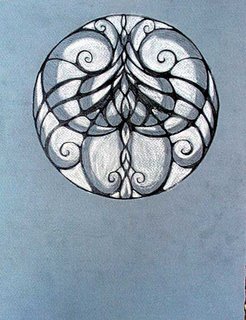 (And you thought the orchid was sexy...)
(And you thought the orchid was sexy...)
You may not even be able to see it in the digital image, but it is shocking how such a subtle adjustment causes the whole image to pull together and almost glow. What it seems to mean at this juncture is that I can start working with more-radical assymetries without losing grasp of the form as a whole. It also starts to make them feel slightly three-dimensional.
Wednesday, June 14, 2006
Bugs
Tuesday, June 13, 2006
Sunday, June 11, 2006
The Obsession Phenomenon

This sort of thing has become my new definition of "poseur." True obsessives are not at art parties; they're at home, rolling in pink paint, or writing unreadable treatises on the interaction of architectural structures with the multi-ethnic psyche. We all know this. Art world people tell you their 'obsessions' because they're desperately trying to be taken seriously as artists. A total lack of balance, perspective and sanity has now become the required state of consciousness for anyone who hopes to catch the eye of a Big-ass Dealer, let alone get a write-up in Art in America.
This is tragic. What does it say about our society and culture, when anyone who wants to make a name as an artist feels compelled to lay claim to mental illness?
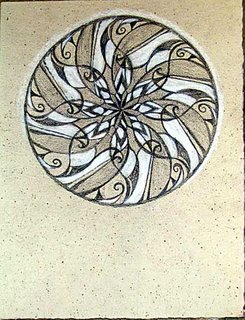
The Van Gogh syndrome has gotten completely out of hand. Poor old Vince himself was a model of wisdom and psychological equilibrium, compared to what is expected of artists these days. We are driven to stake out an obscure aesthetic/conceptual niche and pursue it to ridiculous extremes, at the expense of nearly everything else, except art parties.
Is this helpful? Is it worthwhile? Is it even interesting?
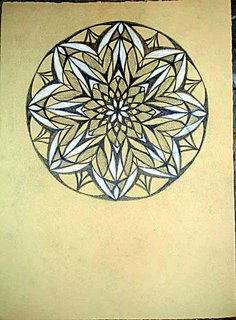
As you may have noticed, I have been drawing some mandalas, lately. I would not go so far as to say that I am obsessed with them; I am, however, doing a lot of them, for no other reason than that I feel compelled to do so. As I work, I notice myself re-learning some principles of classical design, even of architecture; the balance between geometric and organic form, between symmetry and torsion, tension and harmony.
Mainly, though, I would call this a meditative process. Meditation is different from obsession in that it is a process of emptying, not filling; expansion, not narrowing. In all other respects it appears to be the same--a single-minded pursuit of one specific thing. The result, however, tends to be peace of mind, rather than madness.
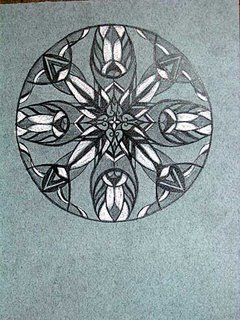
I have no idea what I am going to do with all of these mandalas, but they look sort of nice pinned up in my studio. They create a nice tension with the big, sloppy, non-symmetrical canvases stacked everywhere.

This one is called, I think, "Crater." I'm not sure what I think of it. Actually, that's not true--I think it is beautiful, but I am not confident that anybody else will see its beauty but me. It's difficult, and perhaps just appears foolish.
Monday, June 05, 2006
Today
Being an incurable honest, open person I also let him know that the other tenants and I were going to ask to have the front door repaired and a lock put on, since junkies are living in our foyer, leaving needles and used condoms on the floor, and creating a racket at 4AM.
My landlord accused me of creating 'static' in his building, and refused to sign my lease or take my rent check, effectively threatening to evict me.
I came home, put on the Hilliard Ensemble with Jan Gabarek and drew this.
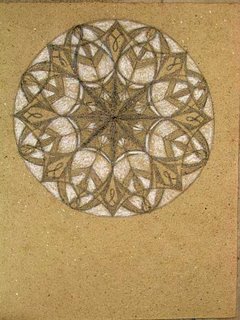
Then I took out a 'problem' painting and painted over the problem area. I'm going to see if I can make it work without any fiddly places at all; just a rose-colored crater full of rose-colored light.
Meditation
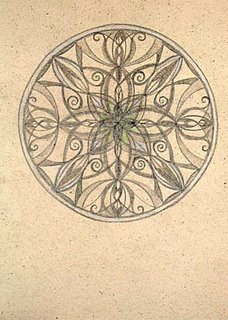
This weekend I finally got around to seeing "Art School Confidential," which was a bit of a disappointment. I felt like they could have taken the satire much farther, and developed the characters a lot more, without resorting to the extremism of a murder plot. There is no shortage of absurd dialogue to be copped in the halls of an art school, and the movie only scratched the surface.
The movie made me think, again and still, about the problem of egotism--the HUGE problem of egotism--in the Art World. A large part of the problem is that most people can't answer the question--if I'm not making art to aggrandize my ego, what am I making it for?
Many artists take refuge in some sort of political or social Message, but I believe that's a red herring. If we're honest with ourselves, we know that people don't change their political beliefs because of an art exhibit, no matter how compelling. Political art is more about the artist's conscience than the effect it has on the external world.
Quite awhile ago, I admitted to myself that for me, art is explicitly a spiritual practice, with an emphasis on the word practice. Not only is the content of my work spiritual, but the actual process of making it is the point. It is about engaging, about being present; when I am truly engaged, I find inner peace. Hopefully this peace will then extend itself to the viewer of the work, although I have little control over that. Truly spiritual art has no agenda--I can't force other people to be peaceful if I'm not there myself.
When I forget why I'm making art, I immediately become miserable and can't work at all. If I get caught up in some Statement that I'm trying to convey, some Original Thing I'm trying to Do, like the Art World expects us to, I'm toast. This is why I frequently get derailed right after getting inspired, by, say, a visit to the Jennifer Coates exhibit or the Rufino Tamayo Museum.
Because largely, I believe, every born artist does what they do. You can study technique, develop your talent and your insight, do your best to live consciously, and work like a dog. But you can't fundamentally decide to be a certain type of artist just because you want to be. You have to figure out what comes naturally, and enhance it.
This is why debates on "should this artist be doing this? Is this Original?" drive me bananas. For me, this is the wrong question. For me, the question is, "Is this Ego, or is it Real?"
That's why, after a week of futzing around with Dr. Seuss paintings, and doing a lot of yoga, secretarial work, and vacuuming, this evening I put on some Gregorian chant and drew a mandala. Boring, I know. Predictable. Decorative.
But working with a rigid, decorative, symmetrical form can be paradoxically freeing. The totally open field of the modern art world can be paralyzing; it's rather like being a miner. 'You're given complete freedom to do anything you like, provided you get hold of two tons of coal every day.'
I've got a curator making a studio visit in a week and a half; this is probably also why I'm stressing. Two tons of mandalas might not be such a bad idea.
Friday, June 02, 2006
Art push-ups
Usually, when I get like this, it helps to build and stretch canvases, gesso them, vacuum, clean brushes, draw mandalas. But today I had to face a deadline--the Nurture Art slide registry and gala donation. Which meant, basically, secretarial work. Blech.
I went to the Nurture Art "Muse Fuse" salon last week, which was wonderful and incredible; people were friendly, the lecturer (Nick Stillman) was hilarious, and I drove a carload of fun people home and booked a studio visit with a curator. So the Nurture Art slide registry is definitely something I want to be part of, and I'm all for donating artwork to support them.
But when I went to fill out the application, something manifested in my gut which was akin to a visceral sort of rage. Let's term it 'resistance.' As I read down the requirements--digital images on CD, different images for online gallery, slides, slide list, résumé--it seemed an impossible, unreasonable requirement that I should spend my afternoon producing these things, instead of actually making the art.
Of course, I've done these things before. Oh, have I. As I thumbed through the files on my hard drive, I noted the long, long list of grant applications, slide registry submissions, exhibition proposals, subway design proposals, residency applications and basic documentation that I've produced over the last few years. With all these, neatly filed under appropriate categories, it seems incredible that it should STILL take so long to produce a new packet; surely I should be able to press "print" and "burn" and have done with it?
No, no. I've produced new work since then, and had other exhibitions, so I have to update the résumé, artist statement, and format the new images. Write new slide lists, remove images of works that have been sold, print new labels, etc.
As I work I notice myself slowly calming down. I start to notice the underlying emotions, pulling my consciousness first one way, then the other. Part of me is thinking, "this work is lame, I haven't done enough in the last year, I'm lazy, I'm embarrassing myself."
Another part of me is noticing, "damn, I've applied for a whole lot of stuff over the years; the amount of work on my hard drive would keep a part-time secretary in business. And these things, ultimately, represent a whole pile of single-sheet, form-letter rejections, plus many hours of unpaid labor that I did instead of painting, plus a quadruple-digit bill for equipment and office supplies. No wonder I'm experiencing resistance."
A third, quieter part of my mind only starts making itself heard after an hour or two has passed. Being forced to look at my portfolio, update it, reformat images, I start to notice the actual work. I notice that there's more of it than I thought, and I like it better than I thought. In fact, I love it; it's beautiful, it's detailed, it's complex and passionate and vital and loving. These paintings are, in fact, my babies.
And my babies came back from their journeys out into the world with single-sheet form letters stamped on their faces; unreviewed, unsold, unappreciated. No wonder it's hard to keep working. It's tough to be a parent.
All artists, of course, go through this. But it's amazing how many times we have to learn the same lessons over and over; 'keep interested in your own career, however humble; it is a real possession in the changing fortunes of time." It's amazing that I forget, nearly ever day, that I love what I do. I keep thinking that if I'm not working right this second then I'm a fraud and a poseur, and should just quit and become a gardener.
Thursday, June 01, 2006
Almost forgot
Admirable thoroughness
Hundreds of badly formed faces peer out of the morass of paint at us, crying out, "Save us! Free us from this blech!" But they will never be freed."I'm not inspired," said Stephanie.
"I am," I replied. "I'm inspired to leave."
Reading Chris' blog, I see that I should never, never be an art critic. I do not have enough patience with art that I don't like, to sufficiently take it in; I merely flee. I am Biassed and Disproportionate. Chris, however, like a truly good journalist, stays with the agenda no matter how painful it gets.
I think I just have to accept that whoever's running things over at Team Gallery and I would not get along. ...This is the second time at Team I've seen paintings where I wish someone would talk to the painter and convince them to take up a profession where they can't do any more damage, like chimney sweeping or dry cleaning. I really think the world would be a better place if people like Lisa Ruyter and Dawn Mellor would stop painting....
One denizen of a painting had a fistful of paintbrushes shoved up their ass, and I honestly can't find a better metaphor for what I thought of these works. I want to put the word "art" in quotes when discussing them. They're hateful and awful. Now, you might be saying, but Chris, the name of the show is We Hope You Choke. What were you expecting? Good question.
And Chris says that I have some 'sharp corners,' online. Is this a gender thing?
No, I see that no matter how hard I pretend, I am not an intellectual. As Deborah Fisher describes in a deeply satisfying post about Art Workers and Art Thinkers, I can fake the Thinking stuff, but deep down, I am a kinesthetic weirdo. I roll around on the floor and do handstands in the studio when nobody is looking. And Deborah champions people like me!
Art thinkers...all went to Columbia and Yale and don't know how to put a drywall screw into a wall but are expert networkers and self-promoters. They get their art made by art workers who blew in from skill-based crappy state school art programs like my alma mater and were never taught to always talk about yourself. Always.
...
To state that the making of the thing matters not because artists are philosophers and not craftspeople is absurdly narrow. There are too many people who are actively thinking with their hands and bodies and coming up with new, relevant propositions for this classist system to make sense.
Finally, I must put in a plug for Danny's upcoming project at TablaRasa in June.
 When designer/puppeteer Brenda Colling combines talents with the scissor wizardry of Danny Scheffer, the result is "Living in the Shadows." This event fuses their skills in design, puppetry, sculpture and theatre into a unique presentation. By combining backlit silhouettes, music and spoken word, they explore an eclipsed world of fleeting, fragmented views.
When designer/puppeteer Brenda Colling combines talents with the scissor wizardry of Danny Scheffer, the result is "Living in the Shadows." This event fuses their skills in design, puppetry, sculpture and theatre into a unique presentation. By combining backlit silhouettes, music and spoken word, they explore an eclipsed world of fleeting, fragmented views. Following this voyage of shadow and light, the artists will speak on the origins of shadow puppetry, and its relationship to other art forms. There will be examples of traditional puppets on hand. The audience is invited to ask questions, and interact with the puppets (time permitting).
This will be happening in the afternoon of June 17, at 2 PM, which I remember because I will not be there, having signed up for BWAC duty, unfortunately the same day that Laurie Anderson is playing for free in Prospect Park. I am looking for a fellow obsessive fan to go to the park at around 4:30 or 5 and save us a spot. I will contribute an excellent picnic, including wine. Any takers?






